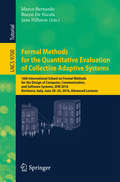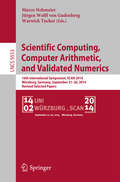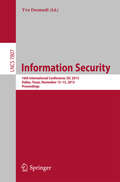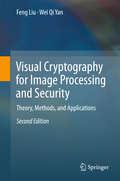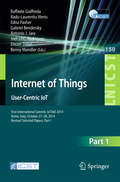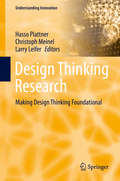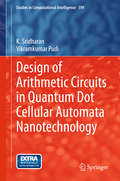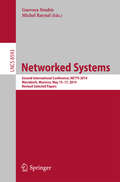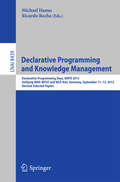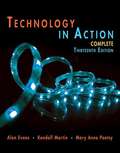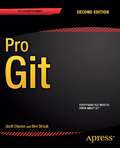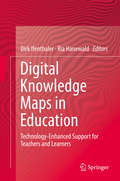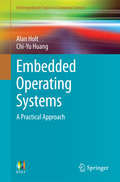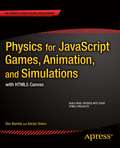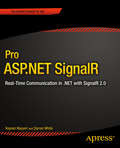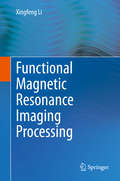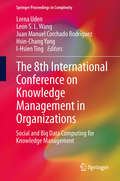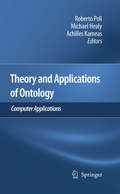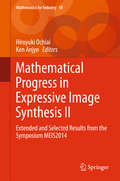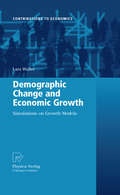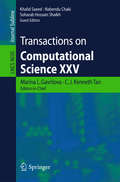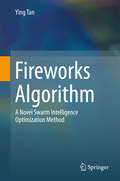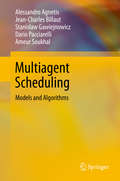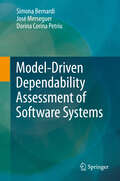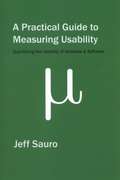- Table View
- List View
Formal Methods for the Quantitative Evaluation of Collective Adaptive Systems
by Marco Bernardo Rocco De Nicola Jane HillstonThis book presents 8 tutorial lectures given by leading researchers at the 16th edition of the International School on Formal Methods for the Design of Computer, Communication and Software Systems, SFM 2016, held in Bertinoro, Italy, in June 2016. SFM 2016 was devoted to the Quantitative Evaluation of Collective Adaptive Systems and covered topics such as self-organization in distributed systems, scalable quantitative analysis, spatio-temporal models, and aggregate programming.
Scientific Computing, Computer Arithmetic, and Validated Numerics
by Warwick Tucker Marco Nehmeier Jürgen Wolff von GudenbergThis book constitutes the refereed post proceedings of the16th International Symposium, SCAN 2014, held in Würzburg, Germany, in September 2014. The 22 full papers presented were carefullyreviewed and selected from 60 submissions. The main concerns of research addressed by SCAN conferences are validation, verification or reliable assertions of numerical computations. Interval arithmetic and other treatments of uncertainty are developed as appropriate tools.
Information Security
by Yvo DesmedtThis book constitutes the thoroughly refereedpost-conference proceedings of the 16th International Conference on InformationSecurity, ISC 2013, held in Dallas, Texas, in November 2013. The 16 revised full papers presented together with 14short papers were carefully reviewed and selected from 70 submissions. Thepapers cover a wide range of topics in the area of cryptography andcryptanalysis and are organized in the following topical sections: security ofoperating systems; secret sharing; encryption; malware and Criticalinfrastructures; cryptanalysis; block ciphers and stream ciphers; entityauthentication; usability & risk perception; access control; computersecurity; privacy attacks; cryptography.
Visual Cryptography for Image Processing and Security
by Feng Liu Wei Qi YanThis unique book describes the fundamental concepts, theories and practice of visual cryptography. The design, construction, analysis, and application of visual cryptography schemes (VCSs) are discussed in detail. Original, cutting-edge research is presented on probabilistic, size invariant, threshold, concolorous, and cheating immune VCS. Features: provides a thorough introduction to the field; examines various common problems in visual cryptography, including the alignment, flipping, cheating, distortion, and thin line problems; reviews a range of VCSs, including XOR-based visual cryptography and security enriched VCS; describes different methods for presenting color content using visual cryptographic techniques; covers such applications of visual cryptography as watermarking, resolution variant VCS, and multiple resolution VCS. This logically-structured and comprehensive work will serve as a helpful reference for all researchers and students interested in document authentication and cryptography.
Internet of Things. User-Centric IoT
by Edna Pasher Raffaele Giaffreda Radu-Laurentiu Vieriu Gabriel Bendersky Antonio J. Jara Joel J.P.C. Rodrigues Eliezer Dekel Benny MandlerThe two-volume set LNICST 150 and 151 constitutes the thoroughly refereed post-conference proceedings of the First International Internet of Things Summit, IoT360 2014, held in Rome, Italy, in October 2014. This volume contains 74 full papers carefully reviewed and selected from 118 submissions at the following four conferences: the First International Conference on Cognitive Internet of Things Technologies, COIOTE 2014; the First International Conference on Pervasive Games, PERGAMES 2014; the First International Conference on IoT Technologies for HealthCare, HealthyIoT 2014; and the First International Conference on IoT as a Service, IoTaaS 2014. The papers cover the following topics: user-centric IoT; artificial intelligence techniques for the IoT; the design and deployment of pervasive games for various sectors, such as health and wellbeing, ambient assisted living, smart cities and societies, education, cultural heritage, and tourism; delivery of electronic healthcare; patient care and medical data management; smart objects; networking considerations for IoT; platforms for IoTaaS; adapting to the IoT environment; modeling IoTaaS; machine to machine support in IoT.
Design Thinking Research
by Christoph Meinel Hasso Plattner Larry LeiferThis book summarizes the results of the second year in the Design Thinking Research Program, a joint venture of Stanford University in Palo Alto and Hasso Plattner Institute in Potsdam. The authors have taken a closer look at the issue of co-creation from different points-of-view. The concept of co-creation can also be applied to the phase in which new ideas and related thought start to influence companies, the economy, our culture, and society. The perpetual pursuit for inventions, new creations and innovations is inherent in human nature. The concept behind co-creation may sound simple, however, it is both an essential element of Design Thinking and highly complex. It is about creating positive synergies for all parties involved.
Design of Arithmetic Circuits in Quantum Dot Cellular Automata Nanotechnology
by K. Sridharan Vikramkumar PudiThis research monograph focuses on the design of arithmetic circuits in Quantum Dot Cellular Automata (QCA). Using the fact that the 3-input majority gate is a primitive in QCA, the book sets out to discover hitherto unknown properties of majority logic in the context of arithmetic circuit designs. The pursuit for efficient adders in QCA takes two forms. One involves application of the new results in majority logic to existing adders. The second involves development of a custom adder for QCA technology. A QCA adder named as hybrid adder is proposed and it is shown that it outperforms existing multi-bit adders with respect to area and delay. The work is extended to the design of a low-complexity multiplier for signed numbers in QCA. Furthermore the book explores two aspects unique to QCA technology, namely thermal robustness and the role of interconnects. In addition, the book introduces the reader to QCA layout design and simulation using QCADesigner. Features & Benefits: This research-based book: ·Introduces the reader to Quantum Dot Cellular Automata, an emerging nanotechnology. ·Explores properties of majority logic. ·Demonstrates application of the properties to design efficient arithmetic circuits. ·Guides the reader towards layout design and simulation in QCADesigner.
Networked Systems
by Guevara Noubir Michel RaynalThis book constitutes the revised selected papers of the Second International Conference on Networked Systems, NETYS 2014, held in Marrakech, Morocco, in May 2014. The 20 full papers and the 6 short papers presented together with 2 keynotes were carefully reviewed and selected from 80 submissions. They address major topics such as multi-core architectures; concurrent and distributed algorithms; middleware environments; storage clusters; social networks; peer-to-peer networks; sensor networks; wireless and mobile networks; as well as privacy and security measures to protect such networked systems and data from attack and abuse.
Declarative Programming and Knowledge Management
by Michael Hanus Ricardo RochaThis book constitutes the proceedings of the Kiel Declarative Programming Days, KDPD 2013, unifying the following conferences: the 20th International Conference on Applications of Declarative Programming and Knowledge Management (INAP 2013), the 22nd International Workshop on Functional and (Constraint) Logic Programming (WFLP 2013) and the 27th Workshop on Logic Programming (WLP 2013), held in Kiel, Germany, in September 2013. The 15 papers presented were carefully and reviewed and selected for inclusion in this book. They cover the following topics: logic programming, constraint problem solving, programmable logic solvers, functional programming and constraint programming.
Technology In Action Complete, 13th Edition
by Alan Evans Kendall Martin Maryanne PoatsyFor introductory courses in computer concepts, digital literacy, or computer literacy, often including instruction in Microsoft Office. Explore, discover, and experience technology with the interactive and adaptive Technology in Action --the book that uses technology to teach technology! This book offers a learning system that pushes the envelope of what is possible in technology, and what is helpful in teaching. Although students are more comfortable with the digital environment than ever, their knowledge of the devices they use every day is still limited. The authors focus on tasks that students can accomplish with their devices, and skills they can apply immediately in the workplace, the classroom, and at home. This book fits the way students are learning today. Note: You are purchasing a standalone product; MyITLab does not come packaged with this content. Students, if interested in purchasing this title with MyITLab, ask your instructor for the correct package ISBN and Course ID. Instructors, contact your Pearson representative for more information
Pro Git
by Ben Straub Scott ChaconPro Git (Second Edition) is your fully-updated guide to Git and its usage in the modern world. Git has come a long way since it was first developed by Linus Torvalds for Linux kernel development. It has taken the open source world by storm since its inception in 2005, and this book teaches you how to use it like a pro. Effective and well-implemented version control is a necessity for successful web projects, whether large or small. With this book you'll learn how to master the world of distributed version workflow, use the distributed features of Git to the full, and extend Git to meet your every need. Written by Git pros Scott Chacon and Ben Straub, Pro Git (Second Edition) builds on the hugely successful first edition, and is now fully updated for Git version 2. 0, as well as including an indispensable chapter on GitHub. It's the best book for all your Git needs. What you'll learn * Effectively use Git, either as a programmer or a project leader * Become a fluent Git user * Master branching, using Git on the server, and on other systems * Integrate Git in your development workflow * Migrate programming projects from other SCMs to Git * Extend Git for your personal project needs * Effectively use GitHub Who this book is for This book is for all open source developers: you are bound to encounter Git somewhere in the course of your working life. Proprietary software developers will appreciate Git's enormous scalability, since it is used for the Linux project, which comprises thousands of developers and testers. Table of Contents 1. Getting Started 2. Git Basics 3. Git Branching 4. Git on the Server 5. Distributed Git 6. GitHub 7. Git Tools 8. Customizing Git 9. Git and Other Systems 10. Git Internals
Digital Knowledge Maps in Education
by Dirk Ifenthaler Ria HanewaldDigital knowledge maps are 'at a glance' visual representations that enable enriching, imaginative and transformative ways for teaching and learning, with the potential to enhance positive educational outcomes. The use of such maps has generated much attention and interest among tertiary education practitioners and researchers over the last few years as higher education institutions around the world begin to invest heavily into new technologies designed to provide online spaces within which to build resources and conduct activities. The key elements of this edited volume will comprise original and innovative contributions to existing scholarship in this field, with examples of pedagogical possibilities as they are currently practiced across a range of contexts. It will contain chapters that address, theory, research and practical issues related to the use of digital knowledge maps in all aspects of tertiary education and draws predominantly on international perspectives with a diverse group of invited contributors. Reports on empirical studies as well as theoretical/conceptual chapters that engage deeply with pertinent questions and issues raised from a pedagogical, social, cultural, philosophical, and/or ethical standpoint are included. Systematic literature reviews dealing with digital knowledge mapping in education are also an integral part of the volume.
Embedded Operating Systems
by Alan Holt Chi-Yu HuangThis practically-oriented textbook provides a clear introduction to the different component parts of an operating system and how these work together. The easy-to-follow text covers the bootloader, kernel, filesystem, shared libraries, start-up scripts, configuration files and system utilities. The procedure for building each component is described in detail, guiding the reader through the process of creating a fully functional GNU/Linux embedded OS. Features: presents a concise overview of the GNU/Linux system, and a detailed review of GNU/Linux filesystems; describes how to build an embedded system to run on a virtual machine, and to run natively on an actual processor; introduces the concept of the compiler toolchain, demonstrating how to develop a cross toolchain so that programs can be built on a range of different architectures; discusses the ARM-based platforms BeagleBone and Raspberry Pi; explains how to build OpenWRT firmware images for OMxP Open-mesh devices and the Dragino MS14 series.
Physics for JavaScript Games, Animation, and Simulations
by Dev Ramtal Adrian DobreHave you ever wanted to include believable physical behaviors in your games and projects to give them that extra edge? Physics for JavaScript Games, Animation, and Simulations teaches you how to incorporate real physics, such as gravity, friction, and buoyancy, into your HTML5 games, animations, and simulations. It also includes more advanced topics, such as particle systems, which are essential for creating effects such as sparks or smoke. The book also addresses the key issue of balancing accuracy and simplicity in your games and simulations, and the final chapters provide you with the information and the code to make the right choice for your project. Physics for JavaScript Games, Animation, and Simulations assumes you have a basic knowledge of JavaScript and HTML5. However, no previous knowledge of physics is required--only some very basic math skills. The authors present everything from basic principles to advanced concepts in an approachable way, so you'll be able to follow the logic and easily adapt the principles to your own applications. The book is packed full of practical examples of how you can apply physics to your own games and applications. Spring behaviors can be used for anything from tweaking lowrider suspension to creating cloth simulation; flotation mechanics enable the simulation of submersibles or dirigibles; you can even create your own solar system with accurate orbits and gravity. It doesn't matter if you're modeling the Lorentz force in an electromagnetic field or you're modeling the lift force in a flight simulator, Physics for JavaScript Games, Animation, and Simulations enables you to fill your games and applications with accurate and realistic effects.
Pro ASP.NET SignalR
by Keyvan Nayyeri Darren WhiteASP. NET SignalR is the new solution to real-time communication between servers and clients in . NET. Use it to push new data to a web page or mobile device as soon as it becomes available, whether it's a notification, live chat, up-to-the-minute financial data, or a range of other exciting applications. Innovations like Google live search and live Facebook and Twitter updates are pushing users' expectations of the real-time web. With Pro ASP. NET SignalR, you can join this revolution and learn skills that will be valuable for years to come. Pro ASP. NET SignalR starts with an introduction to the real-time web. Learn about the technologies underlying the SignalR library, such as WebSockets and long-polling, and how SignalR elegantly flips between them depending on the capabilities of the client. Next, meet the concepts of hubs and persistent connections and how to use them to build the components of an ASP. NET SignalR application. Find out how to extend, test, debug, configure, scale, and host your applications, and how to target a range of clients, including Windows and iOS. The book rounds off with two case studies--a stock market price updater, and a collaborative drawing application--so you can get to grips with SignalR in a realistic scenario, using a broad range of the concepts covered in earlier chapters. As real-time updates to web and mobile apps become the norm, Pro ASP. NET SignalR will be your in-depth, one-stop companion to this new and exciting technology.
Functional Magnetic Resonance Imaging Processing
by Xingfeng LiWith strong numerical and computational focus, this book serves as an essential resource on the methods for functional neuroimaging analysis, diffusion weighted image analysis, and longitudinal VBM analysis. It includes four MRI image modalities analysis methods. The first covers the PWI methods, which is the basis for understanding cerebral flow in human brain. The second part, the book's core, covers fMRI methods in three specific domains: first level analysis, second level analysis, and effective connectivity study. The third part covers the analysis of Diffusion weighted image, i. e. DTI, QBI and DSI image analysis. Finally, the book covers (longitudinal) VBM methods and its application to Alzheimer's disease study.
The 8th International Conference on Knowledge Management in Organizations: Social and Big Data Computing for Knowledge Management
by Lorna Uden I-Hsien Ting Hsin-Chang Yang Leon S.L. Wang Juan Manuel Corchado RodríguezThe proceedings from the eighth KMO conference represent the findings of this international meeting which brought together researchers and developers from industry and the academic world to report on the latest scientific and technical advances on knowledge management in organizations. This conference provided an international forum for authors to present and discuss research focused on the role of knowledge management for innovative services in industries, to shed light on recent advances in social and big data computing for KM as well as to identify future directions for researching the role of knowledge management in service innovation and how cloud computing can be used to address many of the issues currently facing KM in academia and industrial sectors.
Theory and Applications of Ontology: Computer Applications
by Roberto Poli Achilles Kameas Michael HealyOntology was once understood to be the philosophical inquiry into the structure of reality: the analysis and categorization of 'what there is'. Recently, however, a field called 'ontology' has become part of the rapidly growing research industry in information technology. The two fields have more in common than just their name. Theory and Applications of Ontology is a two-volume anthology that aims to further an informed discussion about the relationship between ontology in philosophy and ontology in information technology. It fills an important lacuna in cutting-edge research on ontology in both fields, supplying stage-setting overview articles on history and method, presenting directions of current research in either field, and highlighting areas of productive interdisciplinary contact. Theory and Applications of Ontology: Computer Applications presents ontology in ways that philosophers are not likely to find elsewhere. The volume offers an overview of current research in ontology, distinguishing basic conceptual issues, domain applications, general frameworks, and mathematical formalisms. It introduces the reader to current research on frameworks and applications in information technology in ways that are sure to invite reflection and constructive responses from ontologists in philosophy.
Mathematical Progress in Expressive Image Synthesis II
by Hiroyuki Ochiai Ken AnjyoThe material included in this book provides selected presentations given at the international symposium MEIS2014. The book aims to provide a unique venue where various issues in computer graphics (CG) application fields are discussed by mathematicians as well as CG researchers and practitioners. The target audience is not limited to researchers in academia but also those in industries with a strong interest in digital media creation, scientific visualization and visual engineering.
Demographic Change and Economic Growth: Simulations on Growth Models
by Lars WeberIn this book the author investigates the impact of demographic change on economic growth. As a result of the current financial crisis, a new view on economics has been demanded by various scientists. The author provides such a new view on economic growth, using a methodology of system dynamics. By applying this method, the author focuses on characteristics of complex systems and analyzes aging and shrinking processes, and not only positive growth. Delays and feedback processes are also considered. This leads to deeper and revealing insights into economic behavior. In doing so, a new semi-endogenous growth model is developed by introducing a specific and detailed population sector (demographic growth model). The book shows and analyzes the behavior of such a model and tests several policy scenarios in a transfer chapter to apply the new theoretical approach on real world problems. The major results are summarized in 15 principles of demographic growth.
Transactions on Computational Science XXV
by Khalid Saeed Nabendu Chaki Marina L. Gavrilova C.J. Kenneth Tan Soharab Hossain ShaikhThe LNCS journal Transactions on Computational Science reflects recent developments in the field of Computational Science, conceiving the field not as a mere ancillary science but rather as an innovative approach supporting many other scientific disciplines. The journal focuses on original high-quality research in the realm of computational science in parallel and distributed environments, encompassing the facilitating theoretical foundations and the applications of large-scale computations and massive data processing. It addresses researchers and practitioners in areas ranging from aerospace to biochemistry, from electronics to geosciences, from mathematics to software architecture, presenting verifiable computational methods, findings and solutions and enabling industrial users to apply techniques of leading-edge, large-scale, high performance computational methods. This, the 25th issue of the Transactions on Computational Science journal, consists of two parts. Part I, which is guest edited by Khalid Saeed, Nabendu Chaki and Soharab Hossain Shaikh, covers the areas of computer vision, image processing for biometric security, information fusion, and Kinect activity recognition. The papers in Part II focus on optimization through novel methods for data fusion, clustering in WSN, fault-tolerance, probability, weight assignment and risk analysis.
Fireworks Algorithm
by Ying TanThis book is devoted to the state-of-the-art in all aspects of fireworks algorithm (FWA), with particular emphasis on the efficient improved versions of FWA. It describes the most substantial theoretical analysis including basic principle and implementation of FWA and modeling and theoretical analysis of FWA. It covers exhaustively the key recent significant research into the improvements of FWA so far. In addition, the book describes a few advanced topics in the research of FWA, including multi-objective optimization (MOO), discrete FWA (DFWA) for combinatorial optimization, and GPU-based FWA for parallel implementation. In sequels, several successful applications of FWA on non-negative matrix factorization (NMF), text clustering, pattern recognition, and seismic inversion problem, and swarm robotics, are illustrated in details, which might shed new light on more real-world applications in future. Addressing a multidisciplinary topic, it will appeal to researchers and professionals in the areas of metahuristics, swarm intelligence, evolutionary computation, complex optimization solving, etc.
Multiagent Scheduling
by Jean-Charles Billaut Alessandro Agnetis Stanisław Gawiejnowicz Dario Pacciarelli Ameur SoukhalScheduling theory has received a growing interest since its origins in the second half of the 20th century. Developed initially for the study of scheduling problems with a single objective, the theory has been recently extended to problems involving multiple criteria. However, this extension has still left a gap between the classical multi-criteria approaches and some real-life problems in which not all jobs contribute to the evaluation of each criterion. In this book, we close this gap by presenting and developing multi-agent scheduling models in which subsets of jobs sharing the same resources are evaluated by different criteria. Several scenarios are introduced, depending on the definition and the intersection structure of the job subsets. Complexity results, approximation schemes, heuristics and exact algorithms are discussed for single-machine and parallel-machine scheduling environments. Definitions and algorithms are illustrated with the help of examples and figures.
Model-Driven Dependability Assessment of Software Systems
by Simona Bernardi José Merseguer Dorina Corina PetriuOver the last two decades, a major challenge for researchers working on modeling and evaluation of computer-based systems has been the assessment of system Non Functional Properties (NFP) such as performance, scalability, dependability and security. In this book, the authors present cutting-edge model-driven techniques for modeling and analysis of software dependability. Most of them are based on the use of UML as software specification language. From the software system specification point of view, such techniques exploit the standard extension mechanisms of UML (i. e. , UML profiling). UML profiles enable software engineers to add non-functional properties to the software model, in addition to the functional ones. The authors detail the state of the art on UML profile proposals for dependability specification and rigorously describe the trade-off they accomplish. The focus is mainly on RAMS (reliability, availability, maintainability and safety) properties. Among the existing profiles, they emphasize the DAM (Dependability Analysis and Modeling) profile, which attempts to unify, under a common umbrella, the previous UML profiles from literature, providing capabilities for dependability specification and analysis. In addition, they describe two prominent model-to-model transformation techniques, which support the generation of the analysis model and allow for further assessment of different RAMS properties. Case studies from different domains are also presented, in order to provide practitioners with examples of how to apply the aforementioned techniques. Researchers and students will learn basic dependability concepts and how to model them using UML and its extensions. They will also gain insights into dependability analysis techniques through the use of appropriate modeling formalisms as well as of model-to-model transformation techniques for deriving dependability analysis models from UML specifications. Moreover, software practitioners will find a unified framework for the specification of dependability requirements and properties of UML, and will benefit from the detailed case studies.
A Practical Guide To Measuring Usability: 72 Answers To The Most Common Questions About Quantifying The Usability Of Websites And Software
by Jeff SauroA detailed and readable guide that answers the most common questions that arise when measuring the usability of websites, software or cellphones. What measures do you take? What do have users do? What questionnaires do you use? What about sample size and statistical analysis?
